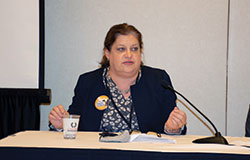
One potential tool in the future is the use of feed supplements that could reduce enteric greenhouse gas emissions. The opportunity to transform feed supplements from promising to a real solution was examined during a virtual panel discussion held as part of the Sustainable Agriculture Summit in Las Vegas, Nev.
One of the panel members was Suzanne Vold, a dairy farmer representative on the Innovation Center for U.S. Dairy’s Environmental Stewardship Committee. Vold and her family operate Dorrich Dairy near Glenwood in west central Minnesota. She emphasized their commitment to improving the environment.
“Sustainability is important to all of us on our farm, because as dairy farmers, the health of our cows, the health of our land, and the health of our families is extremely important to us,” she said. “We look at sustainability from the cow side, and we protect the land, air, and water we use because we live where we work.”
Vold shared several changes they made to their farm over the years, including a drum system that composts manure into bedding. They also made the switch to an automated milking system in the fall of 2019 as a way to better care for their cows, which Vold called their most important asset.
As for feed supplements, Vold said, “This topic is exciting because I think it could have a big impact on our carbon footprint without making a huge capital investment. Yes, there is a cost to using those additives, but it’s not the same as putting in large pieces of equipment.”
Proven success
Before using a supplement on their farm, Vold said they would want to see a product go through plenty of research trials to be sure it achieved the desired results consistently. It is also important that the product be tested on farms comparable to theirs.
“Dairy farms are very different, due to climate, soil type, and the type of feeds that are fed,” she said. “A lot changes with geography. I would like to know these additives worked in a similar climate and on farms similar to mine.”
She continued, “We would rely heavily on our nutritionist and veterinarian to help us make these decisions, as they would be the ones reviewing the data with a more trained eye. They know us, they know our farm, and they know the technology we are working with.”
Vold would also want to know that the product was tested on cows at various stages of lactation, and any changes to the ration would need to be done at the right pace.
“Consistency is key for cows. When we make ration changes, we do it slowly and gradually,” she explained.
Safety comes first
When asked what she would not be willing to give up in order to reduce enteric methane emissions, Vold said that was an easy answer.
“I’m not willing to trade the health of my cows,” she said. “Cow safety, both short term and long term, is important to me.”
Production is, of course, another area of consideration.
“If there is not a milk production and or component increase, I have to make an economic decision,” she said. “Are these additives really providing a benefit?”
Also important is what these supplements do when they leave the cow.
“I need to look at what are they doing to our manure,” Vold shared. “Our manure is an asset for us. We use it for fertilizer; it is our primary fertilizer for the crops we grow to feed our cows. If the composition of the manure changes, if the nutrient that reaches our crops changes and I have to purchase more commercial fertilizer, that is another tradeoff I need to look at when I make this decision.”
Vold was asked what she believed to be the biggest hurdles for adoption among farmers.
“On our farm, our value statement is ‘Leaving it better than when we came,’” she said. “That is something we are always trying to do. In order for us to do that, we need to make sure those things we are changing are really effective.”
Consumer acceptance is also part of the equation.
“The other side of this coin for is consumers and the community at large recognizing the value of our milk that comes from supplements that reduce enteric methane,” she said. “What is it going to take to help educate the general public, the people consuming these dairy products, that they are safe and effective? What do we need to do for education?”
She added, “I am making the assumption that these additives are already tested and proven safe for humans. As a producer that makes products for human consumption, I would never dream of considering them if not able to be safely consumed by humans in milk.”
Vold said that she is excited for the opportunity feed supplements could provide, but it is going to require collaboration along the entire dairy product chain.
“From farmers to vets, to nutritionists providing incentives through their company partners, and even working with processors and retailers to make sure consumers understand why we are using these supplements and their benefits — it is going to depend on all of us working together,” she said.
The other panelists agreed that more work must be done to prove the effectiveness of supplements, both in how they affect livestock productivity and their true benefit in reducing emissions. They saw cost as a potential hurdle for farmer acceptance, and it was suggested that financial incentives may be needed to encourage use. It was also reiterated that any supplement fed to cattle would need to be proven safe for both animal and human consumption. Still, the group shared enthusiasm that feed supplements could have a potential impact on reducing enteric methane emissions somewhere down the road.
This article appeared in the February 2022 issue of Journal of Nutrient Management on pages 20 and 21. Not a subscriber? Click to get the print magazine.










